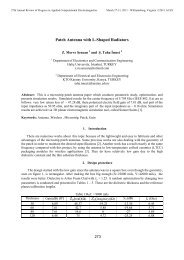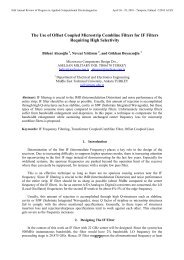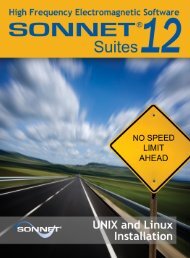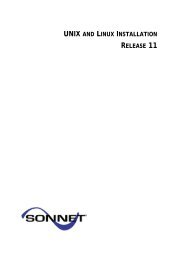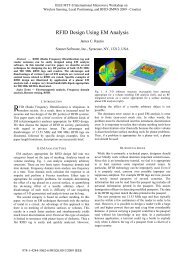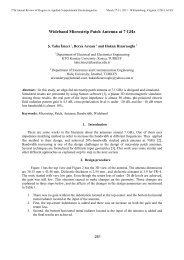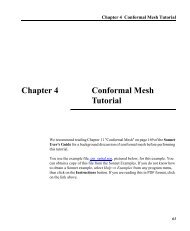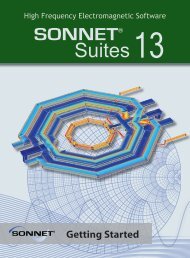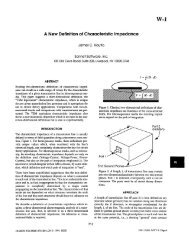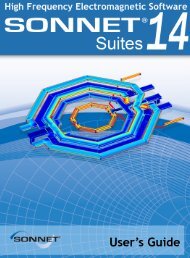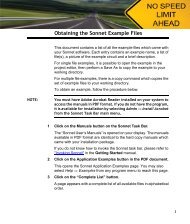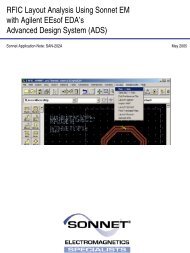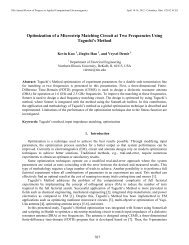Attend any session and Receive Sonnet Lite Plus ... - Sonnet Software
Attend any session and Receive Sonnet Lite Plus ... - Sonnet Software
Attend any session and Receive Sonnet Lite Plus ... - Sonnet Software
You also want an ePaper? Increase the reach of your titles
YUMPU automatically turns print PDFs into web optimized ePapers that Google loves.
Free EM <strong>Software</strong> Training<br />
20 minute, h<strong>and</strong>s-on training in <strong>Sonnet</strong>’s Booth #2524<br />
<strong>Attend</strong> <strong>any</strong> <strong>session</strong> <strong>and</strong><br />
<strong>Receive</strong> <strong>Sonnet</strong> <strong>Lite</strong> <strong>Plus</strong> FREE<br />
($495 value)<br />
High Frequency Electromagnetic <strong>Software</strong><br />
(877) 7-SONNET<br />
www.sonnetsoftware.com
class schedule<br />
Tuesday<br />
25 May<br />
Wednesday<br />
26 May<br />
Thursday<br />
27 May<br />
9:30 am<br />
Intro: A Single<br />
Stub Tuner<br />
Intro: CPW<br />
Modeling<br />
Intro: Parametric<br />
CPW Z 0<br />
10:30 am<br />
11:30 am<br />
12:30 pm<br />
1:30 pm<br />
Intro: CPW<br />
Modeling<br />
<strong>Sonnet</strong> Interface:<br />
AWR MWO®<br />
Via Modeling<br />
with EM<br />
Intro:<br />
Discontinuity<br />
Modeling with EM<br />
<strong>Sonnet</strong> Interface:<br />
Cadence<br />
Virtuoso<br />
<strong>Sonnet</strong> Release 13<br />
Preview<br />
Spiral Inductor<br />
Modeling<br />
<strong>Sonnet</strong> Interface:<br />
Agilent ADS<br />
Modeling PCBs<br />
with SMDs in EM<br />
2:30 pm<br />
3:30 pm<br />
4:30 pm<br />
Fast EM-based<br />
Filter Design<br />
High Performance<br />
EM Computing<br />
Modeling<br />
Anisotropic<br />
Substrates<br />
EM-based TLine<br />
Model Extraction<br />
4 GHz Suspended<br />
Stripline Coupler<br />
Fast EM-based<br />
Filter Design<br />
Driving <strong>Sonnet</strong><br />
with Matlab®<br />
Surface<br />
Roughness<br />
Modeling in EM<br />
Spiral Inductor<br />
Modeling<br />
Intro to CST MWS®:<br />
Coax to µStrip<br />
All classes are 20 minutes <strong>and</strong> will be held in <strong>Sonnet</strong>’s booth #2524<br />
Laptops for training are provided for all appropriate classes
class abstracts<br />
Intro: A Single Stub Tuner in 40 clicks<br />
Live training to teach you to drive the<br />
<strong>Sonnet</strong> high frequency EM simulator. Setup<br />
<strong>and</strong> simulate a <strong>Sonnet</strong> project with a<br />
h<strong>and</strong>s-on planar microstrip filter example.<br />
This class is suitable for first time users.<br />
Intro: CPW Modeling<br />
Learn to drive the <strong>Sonnet</strong> high frequency<br />
EM simulator with this introductory<br />
h<strong>and</strong>s-on lab. We will teach you to use the<br />
<strong>Sonnet</strong> environment to model coplanar<br />
waveguide (CPW) transmission line<br />
structures. Learn the ropes with CPW<br />
port setup, <strong>and</strong> receive tips that will lead<br />
you to accurate modeling of conductorbacked<br />
<strong>and</strong> topside-only CPW designs.<br />
<strong>Sonnet</strong> Interface: AWR MWO<br />
AWR Microwave Office users can easily<br />
access the <strong>Sonnet</strong> Suites 3D planar EM<br />
simulators from the MWO environment.<br />
Let us show you how to use <strong>Sonnet</strong> as<br />
your EM simulation <strong>and</strong> EM extraction client<br />
with live demonstrations of interoperability<br />
between MWO <strong>and</strong> <strong>Sonnet</strong>.<br />
Via Modeling with EM<br />
In this <strong>session</strong> you will create <strong>and</strong> simulate<br />
a st<strong>and</strong>ard PCB via <strong>and</strong> extract an<br />
equivalent circuit model that can be used<br />
in other circuit simulators or for designer<br />
insight.<br />
Fast EM-based Filter Design<br />
<strong>Sonnet</strong> demonstrates its ability to apply<br />
optimization with EM accuracy at circuit<br />
theory speeds. Watch <strong>and</strong> participate<br />
as a 60 GHz interdigital b<strong>and</strong>pass filter<br />
is designed from start to finish, utilizing<br />
<strong>Sonnet</strong>’s emCluster computing. A mustsee<br />
for <strong>any</strong> filter designer.<br />
High Performance EM Computing<br />
Learn to leverage the latest computing<br />
hardware technology to run the fastest<br />
EM simulations possible! We’ll show you<br />
how the <strong>Sonnet</strong> High Performance Solver<br />
utilizes parallel processing on multi-core<br />
CPUs to model each frequency, uses 64-<br />
Bit technology to model extraordinarily<br />
large circuits <strong>and</strong> uses a cluster computing<br />
environment to drastically reduce<br />
model simulation time.<br />
Modeling Anisotropic Substrates<br />
It turns out nearly all substrate materials<br />
are anisotropic, i.e., the dielectric constant<br />
depends on the direction. A common<br />
problem caused by anisotropy is<br />
that your filter design has the right center<br />
frequency, but the wrong b<strong>and</strong>width. We<br />
show how to easily measure anisotropy<br />
<strong>and</strong> include its effect in your <strong>Sonnet</strong> EM<br />
analyses.<br />
Spiral Inductor Modeling<br />
H<strong>and</strong>s-on training for the MMIC or RFIC<br />
designer. Create <strong>and</strong> simulate a spiral<br />
inductor in a typical semiconductor<br />
process, starting with inductor layout<br />
<strong>and</strong> process stack, <strong>and</strong> ending with data<br />
curves to show how inductance <strong>and</strong> Q<br />
vary with frequency. Learn how easily<br />
planar spiral inductor designs can be<br />
developed <strong>and</strong> simulated in the <strong>Sonnet</strong><br />
3D planar EM environment.<br />
Intro: Discontinuity Modeling with EM<br />
Learn to drive the <strong>Sonnet</strong> high frequency<br />
EM simulator in this h<strong>and</strong>s-on <strong>session</strong>.<br />
You will use <strong>Sonnet</strong>’s packaged application<br />
examples <strong>and</strong> examine the process<br />
of extracting equivalent electrical models<br />
for common (<strong>and</strong> unusual) planar circuit<br />
discontinuities. Examples include a transmission<br />
line step width, tapered width,<br />
line bend <strong>and</strong> a notched line.<br />
<strong>Sonnet</strong> Interface: Cadence Virtuoso<br />
<strong>Sonnet</strong> provides Cadence Virtuoso users<br />
with an integrated high frequency EM<br />
model extraction client. We’ll demonstrate<br />
how to take a Cadence Virtuoso<br />
layout cell, auto-launch an EM simulation,<br />
<strong>and</strong> automatically incorporate EM<br />
extraction models for frequency <strong>and</strong> time<br />
domain simulation with Cadence Spectre<br />
<strong>and</strong> Spectre/RF. If you are designing<br />
RFICs <strong>and</strong> need an accurate, efficient <strong>and</strong><br />
hassle-free EM model extractor for good<br />
RF models, please join us!
<strong>Sonnet</strong> Release 13 Preview<br />
The new <strong>Sonnet</strong> Suites Release 13 is in<br />
the development pipeline. Significant<br />
features are planned for planar component<br />
modeling, equivalent circuit model<br />
extraction, <strong>and</strong> further enhancements in<br />
processing speed. In this presentation,<br />
we’ll give you a sneak preview of some<br />
of the major new features <strong>and</strong> enhancements<br />
coming in Release 13.<br />
EM-based TLine Model Extraction<br />
Live training to teach you to drive the<br />
<strong>Sonnet</strong> high frequency EM simulator. You<br />
will learn to simulate single <strong>and</strong> coupled<br />
planar microwave transmission lines, <strong>and</strong><br />
extract various transmission line parameters<br />
(Normal Modes, RLGC matrixes,<br />
Propagation Constants, etc.). This class is<br />
suitable for new users.<br />
4 GHz Suspended Stripline Coupler<br />
We’ll show you a fast <strong>and</strong> accurate way to<br />
tune/optimize a planar coupler design implemented<br />
in suspended stripline using<br />
a combination of circuit theory <strong>and</strong> EM<br />
analysis with AWR Microwave Office <strong>and</strong><br />
<strong>Sonnet</strong>. See how <strong>Sonnet</strong>’s Co-calibrated<br />
Ports can be used to introduce incremental<br />
tuning ports, giving your circuit design<br />
tool access to new <strong>and</strong> highly accurate<br />
tuning <strong>and</strong> optimization capabilities.<br />
Intro to CST MWS: Coax to uStrip<br />
Learn to drive the CST Microwave Studio<br />
(MWS) full 3D EM simulator. Create<br />
<strong>and</strong> simulate a full 3D model of a coax<br />
to microstrip transition. See electrical<br />
performance <strong>and</strong> powerful visualization<br />
features. You will see why CST MWS is<br />
heralded as the industry’s most intuitive<br />
<strong>and</strong> powerful full 3D high frequency EM<br />
simulator.<br />
Intro: Parametric CPW Z 0<br />
Learn to create your own characteristic<br />
impedance (Z 0<br />
) curves based on swept<br />
geometry parameter analysis in the <strong>Sonnet</strong><br />
EM simulator. In this lab, you will<br />
start with a CPW transmission line, apply<br />
a geometry control parameter, <strong>and</strong> with<br />
a single analysis create a Z 0<br />
curve parameterized<br />
to geometry variation.<br />
<strong>Sonnet</strong> Interface: Agilent ADS<br />
Agilent ADS users have the opportunity<br />
to use <strong>Sonnet</strong>’s shielded-domain 3D planar<br />
EM simulation as a direct simulation<br />
client within ADS. We’ll demonstrate how<br />
to drive <strong>Sonnet</strong> from the ADS schematic,<br />
the ADS layout, from the Momentum<br />
EM simulator settings or simply import<br />
pre-existing <strong>Sonnet</strong> projects (including<br />
layout) into ADS schematic look-alike<br />
elements.<br />
Modeling PCBs with SMDs in EM<br />
Learn to incorporate surface mount<br />
devices (SMDs) in RF printed circuit board<br />
(PCB) simulations in the <strong>Sonnet</strong> EM analysis<br />
environment. You will build up <strong>and</strong><br />
simulate an RF power amplifier design<br />
on a popular microwave PCB material,<br />
incorporate an RF Power GaN HEMT in<br />
SMD format, <strong>and</strong> conduct EM simulation<br />
on the full circuit. Warning: High power<br />
circuit!<br />
Driving <strong>Sonnet</strong> with Matlab<br />
Learn to drive the <strong>Sonnet</strong> high frequency<br />
EM simulator from Matlab. Generate <strong>and</strong><br />
manipulate <strong>Sonnet</strong> projects from Matlab<br />
using the new <strong>Sonnet</strong> / Matlab API. This<br />
class is suitable for those familiar with<br />
<strong>Sonnet</strong> <strong>and</strong>/or Matlab.<br />
Surface Roughness Modeling in EM<br />
A typical PCB electro-deposited foil will<br />
have 3 microns RMS surface roughness,<br />
required for good adhesion. However,<br />
surface roughness increases loss. Previous<br />
models either grossly over- or under-estimate<br />
roughness loss. In addition, these<br />
old models fail to include the substantial<br />
(up to 15%) effect roughness has on<br />
effective dielectric constant. We demonstrate<br />
how these problems are now<br />
completely solved.<br />
Agilent <strong>and</strong> ADS are trademarks of Agilent Technologies.<br />
Matlab is a registered trademark of The Mathworks, Inc.<br />
Cadence <strong>and</strong> Virtuoso are trademarks of Cadence Design Systems, Inc.<br />
AWR <strong>and</strong> Microwave Office are registered trademarks of Applied Wave Research, Inc.<br />
CST Microwave Studio is a registered trademark of CST & Computer Simulation Technology AG.



